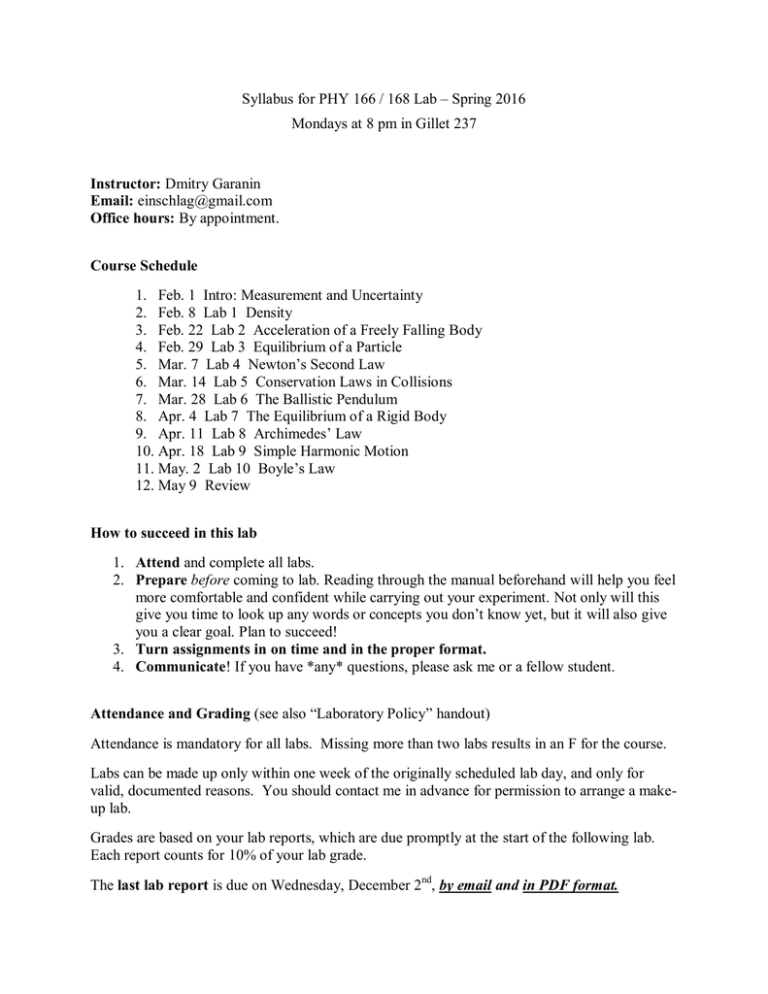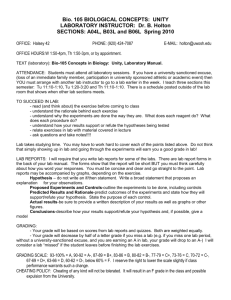Syllabus for PHY 166 / 168 Lab – Spring 2016 Mondays at 8 pm in
advertisement

Syllabus for PHY 166 / 168 Lab – Spring 2016 Mondays at 8 pm in Gillet 237 Instructor: Dmitry Garanin Email: einschlag@gmail.com Office hours: By appointment. Course Schedule 1. Feb. 1 Intro: Measurement and Uncertainty 2. Feb. 8 Lab 1 Density 3. Feb. 22 Lab 2 Acceleration of a Freely Falling Body 4. Feb. 29 Lab 3 Equilibrium of a Particle 5. Mar. 7 Lab 4 Newton’s Second Law 6. Mar. 14 Lab 5 Conservation Laws in Collisions 7. Mar. 28 Lab 6 The Ballistic Pendulum 8. Apr. 4 Lab 7 The Equilibrium of a Rigid Body 9. Apr. 11 Lab 8 Archimedes’ Law 10. Apr. 18 Lab 9 Simple Harmonic Motion 11. May. 2 Lab 10 Boyle’s Law 12. May 9 Review How to succeed in this lab 1. Attend and complete all labs. 2. Prepare before coming to lab. Reading through the manual beforehand will help you feel more comfortable and confident while carrying out your experiment. Not only will this give you time to look up any words or concepts you don’t know yet, but it will also give you a clear goal. Plan to succeed! 3. Turn assignments in on time and in the proper format. 4. Communicate! If you have *any* questions, please ask me or a fellow student. Attendance and Grading (see also “Laboratory Policy” handout) Attendance is mandatory for all labs. Missing more than two labs results in an F for the course. Labs can be made up only within one week of the originally scheduled lab day, and only for valid, documented reasons. You should contact me in advance for permission to arrange a makeup lab. Grades are based on your lab reports, which are due promptly at the start of the following lab. Each report counts for 10% of your lab grade. The last lab report is due on Wednesday, December 2nd, by email and in PDF format. Lab Report Format Lab reports are to be typed in 12 point, Times New Roman font and double spaced. Equations must also be typed. You can do this in Microsoft Word or your favorite word processing program. If you are using Word, you will find the “Equation” menu under the “Insert” tab. Graphs must be computer generated. Construct graphs and tables using Microsoft Excel or another preferred computer program. (Note: Some labs require hand-drawn sketches. Please attach or scan and turn these in with your lab report.) Every lab report should include all five sections listed below. Proofread your reports before turning them in. Lab Report Sections (see also "Writing a laboratory report" in your lab manual) 1. Cover Page: Name, date, and title of the experiment, on a separate page. 2. Abstract: Describe in your own words what you did in the experiment and why. Your abstract should include one or two sentences each for Purpose, Methods and Conclusions. Purpose: What physical principle or law does this experiment test? Methods: What apparatus did you use? How did you analyze the data? Conclusions: Do your results support the physical principle or law? Describe any significant experimental errors or uncertainties. 3. Data: All raw data gathered during the experiment. There is no need to retype your data. Instead I would prefer that you hand in the original record made during the lab session. 4. Calculations and Analysis: Answer all questions in the lab manual. As instructed give calculated values, plots of data, averages, percent errors and uncertainties. 5. Conclusion: Include the following information: Do your results support the physical law being tested? What are the sources or error? Are there ways you could have improved your experimental results? Also answer any specific questions posed by your lab instructor. Plagiarism Plagiarism of any form will not be tolerated. This includes, but is not limited to, copying all or even part of another student’s lab report and copying from any text without properly quoting and citing your source. Plagiarized work will result in a grade of zero for that lab. In the case of work copied from another student, both students’ labs will receive a zero. You can find Lehman College’s official statement on academic integrity in the 2013-2015 Undergraduate Bulletin or online at http://www.lehman.edu/undergraduate-bulletin/academicintegrity.htm.




